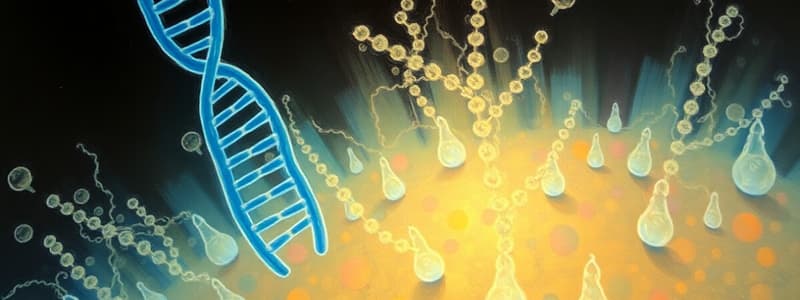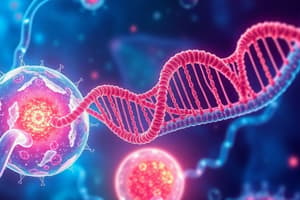Podcast
Questions and Answers
What is the primary location of the citric acid cycle within a eukaryotic cell?
What is the primary location of the citric acid cycle within a eukaryotic cell?
- Cytoplasm
- Cell membrane
- Mitochondria (correct)
- Nucleus
Which metabolic process directly results in the synthesis of glycogen?
Which metabolic process directly results in the synthesis of glycogen?
- Glycogenesis (correct)
- Glycolysis
- Glycogenolysis
- Gluconeogenesis
What is the main function of gluconeogenesis in metabolism?
What is the main function of gluconeogenesis in metabolism?
- Producing glucose from non-carbohydrate sources (correct)
- Breaking down glucose into pyruvate
- Storing glucose as glycogen
- Generating ATP from glucose
Which molecule is essential for transporting fatty acids into the mitochondria for β-oxidation?
Which molecule is essential for transporting fatty acids into the mitochondria for β-oxidation?
Which metabolic pathway produces the highest yield of ATP per molecule of glucose?
Which metabolic pathway produces the highest yield of ATP per molecule of glucose?
In the citric acid cycle, which molecule is generated that subsequently feeds into the electron transport chain?
In the citric acid cycle, which molecule is generated that subsequently feeds into the electron transport chain?
What role does coenzyme A play in fatty acid metabolism?
What role does coenzyme A play in fatty acid metabolism?
Which molecule is the end product formed during anaerobic glycolysis?
Which molecule is the end product formed during anaerobic glycolysis?
What role does NAD⁺ primarily play in metabolic processes?
What role does NAD⁺ primarily play in metabolic processes?
Which statement is accurate regarding the citric acid cycle?
Which statement is accurate regarding the citric acid cycle?
What type of fatty acids undergo β-oxidation for energy production?
What type of fatty acids undergo β-oxidation for energy production?
In the citric acid cycle, which molecule is regenerated to continue the cycle?
In the citric acid cycle, which molecule is regenerated to continue the cycle?
What is the primary function of lipoproteins in human physiology?
What is the primary function of lipoproteins in human physiology?
Which lipoprotein is commonly associated with increased risk of cardiovascular disease?
Which lipoprotein is commonly associated with increased risk of cardiovascular disease?
What molecule is formed as a result of glycolysis, which directly enters the citric acid cycle?
What molecule is formed as a result of glycolysis, which directly enters the citric acid cycle?
During prolonged fasting, which molecule primarily provides energy for cells?
During prolonged fasting, which molecule primarily provides energy for cells?
What substance is released during the oxidative deamination of glutamate?
What substance is released during the oxidative deamination of glutamate?
Which metabolic pathway is known to generate the highest amount of ATP from a single glucose molecule?
Which metabolic pathway is known to generate the highest amount of ATP from a single glucose molecule?
In which cellular compartment does β-oxidation of fatty acids predominantly occur?
In which cellular compartment does β-oxidation of fatty acids predominantly occur?
Which enzyme is crucial for activating fatty acids for β-oxidation?
Which enzyme is crucial for activating fatty acids for β-oxidation?
What is produced at the end of one cycle of β-oxidation?
What is produced at the end of one cycle of β-oxidation?
What is the primary function of the citric acid cycle in cellular metabolism?
What is the primary function of the citric acid cycle in cellular metabolism?
Which transport mechanism is important for moving fatty acids into mitochondria for β-oxidation?
Which transport mechanism is important for moving fatty acids into mitochondria for β-oxidation?
Which substance is not typically produced or consumed during the citric acid cycle?
Which substance is not typically produced or consumed during the citric acid cycle?
Flashcards
Citric Acid Cycle Location
Citric Acid Cycle Location
The citric acid cycle, also known as the Krebs cycle, occurs in the mitochondria.
Glycogenesis Definition
Glycogenesis Definition
Glycogenesis is the process of storing glucose as glycogen.
Gluconeogenesis Purpose
Gluconeogenesis Purpose
Gluconeogenesis creates glucose from non-carbohydrate sources.
Fatty Acid Transport
Fatty Acid Transport
Signup and view all the flashcards
ATP Production in Respiration
ATP Production in Respiration
Signup and view all the flashcards
Citric Acid Cycle Product for ETC
Citric Acid Cycle Product for ETC
Signup and view all the flashcards
Coenzyme A's Role in Metabolism
Coenzyme A's Role in Metabolism
Signup and view all the flashcards
Anaerobic Glycolysis End Product
Anaerobic Glycolysis End Product
Signup and view all the flashcards
NAD⁺'s role in metabolism
NAD⁺'s role in metabolism
Signup and view all the flashcards
Citric Acid Cycle Products
Citric Acid Cycle Products
Signup and view all the flashcards
β-oxidation substrates
β-oxidation substrates
Signup and view all the flashcards
Citric Acid Cycle Final Product
Citric Acid Cycle Final Product
Signup and view all the flashcards
Lipoprotein Function
Lipoprotein Function
Signup and view all the flashcards
Bad Cholesterol
Bad Cholesterol
Signup and view all the flashcards
Fatty Acid Synthesis Precursor
Fatty Acid Synthesis Precursor
Signup and view all the flashcards
Prolonged Fasting Energy Source
Prolonged Fasting Energy Source
Signup and view all the flashcards
Sucrose composition
Sucrose composition
Signup and view all the flashcards
Glycogen function
Glycogen function
Signup and view all the flashcards
Cellulose indigestibility
Cellulose indigestibility
Signup and view all the flashcards
Starch breakdown enzyme
Starch breakdown enzyme
Signup and view all the flashcards
Protein metabolism types
Protein metabolism types
Signup and view all the flashcards
Amino acid primary role
Amino acid primary role
Signup and view all the flashcards
Oxidative deamination process
Oxidative deamination process
Signup and view all the flashcards
β-oxidation location
β-oxidation location
Signup and view all the flashcards
Study Notes
DNA and RNA
- DNA stands for deoxyribonucleic acid
- RNA's primary function is to build proteins
- DNA differs from RNA by containing thymine instead of uracil, and being double-stranded.
RNA Types
- mRNA, tRNA, and rRNA are all involved in protein synthesis
DNA Replication
- Helicase unwinds DNA during replication
Transcription
- mRNA is synthesized from a DNA template during transcription
Mutations
- Substitution mutations replace one base with another
Cellular Energy
- ATP is the cell's energy currency
Carbohydrates
- Monosaccharides are the simplest carbohydrates
- Glucose is known as blood sugar
- Glycosidic bonds link monosaccharides to form disaccharides
- Sucrose is composed of glucose and fructose
Protein Metabolism
- Protein synthesis, digestion, and turnover are types of protein metabolism
- Amino acids are essential for forming enzymes and hormones
Oxidative Deamination
- Ammonia is produced during oxidative deamination of glutamate
Fatty Acid Oxidation
- ẞ-oxidation occurs in mitochondria
- Acetyl-CoA is the product of one round of fatty acid ẞ-oxidation
- Acetyl-CoA synthetase activates fatty acids before entry into ẞ-oxidation
Lipoproteins
- Lipoproteins transport lipids in the bloodstream
- LDL is often referred to as "bad cholesterol"
Citric Acid Cycle
- Oxaloacetate is the last product of the citric acid cycle
- The citric acid cycle generates ATP, NADH, and FADH2
Cellular Respiration
- The electron transport chain produces most ATP in cellular respiration
- The citric acid cycle and electron transport chain produce most ATP from glucose
- Oxygen is the final electron acceptor in the electron transport chain
- ADP and inorganic phosphate are required to form ATP
Glycolysis
- Glucose-6-phosphate is the first molecule formed during glycolysis
- Pyruvate is the product of glucose conversion in glycolysis
- Glycogen is a major energy source during the first 30 minutes of exercise.
Gluconeogenesis
- Gluconeogenesis produces glucose from non-carbohydrate precursors
Glycogen Synthesis
- Glycogenesis is the process of glycogen synthesis
Fatty Acid Metabolism
- Triglycerides are the primary form of fat storage
Studying That Suits You
Use AI to generate personalized quizzes and flashcards to suit your learning preferences.



